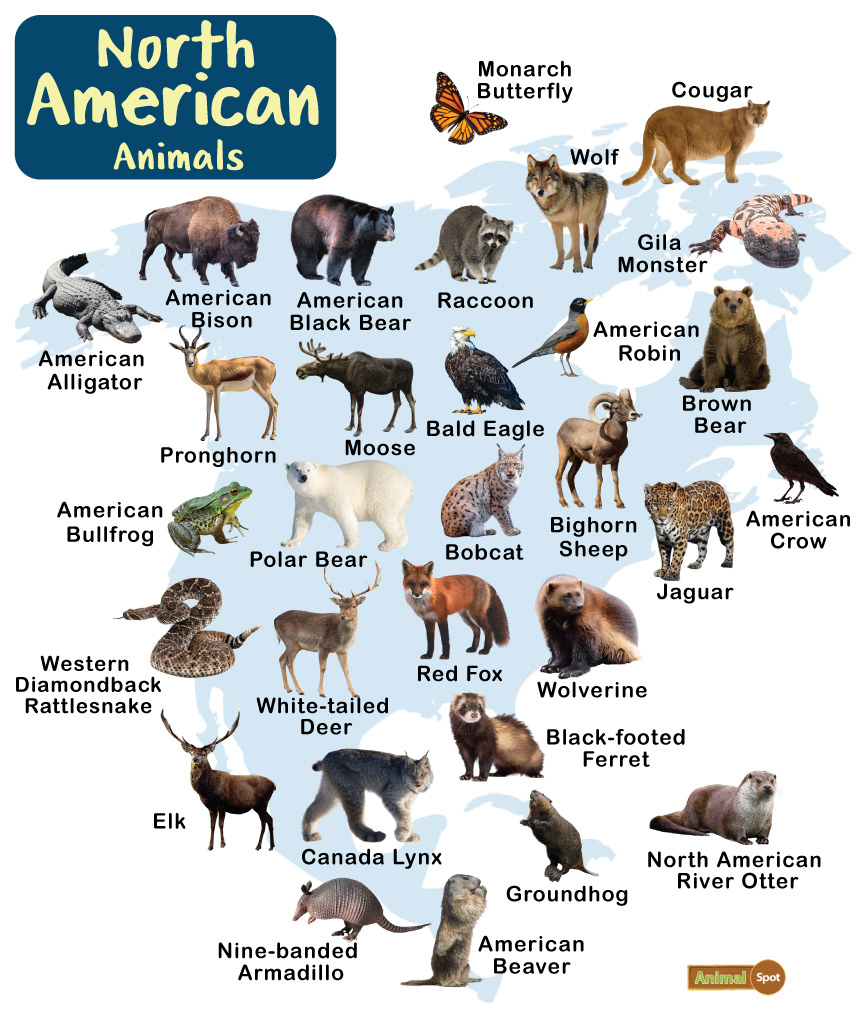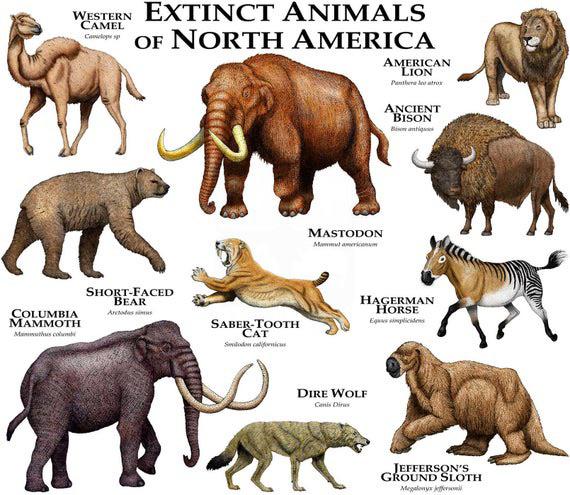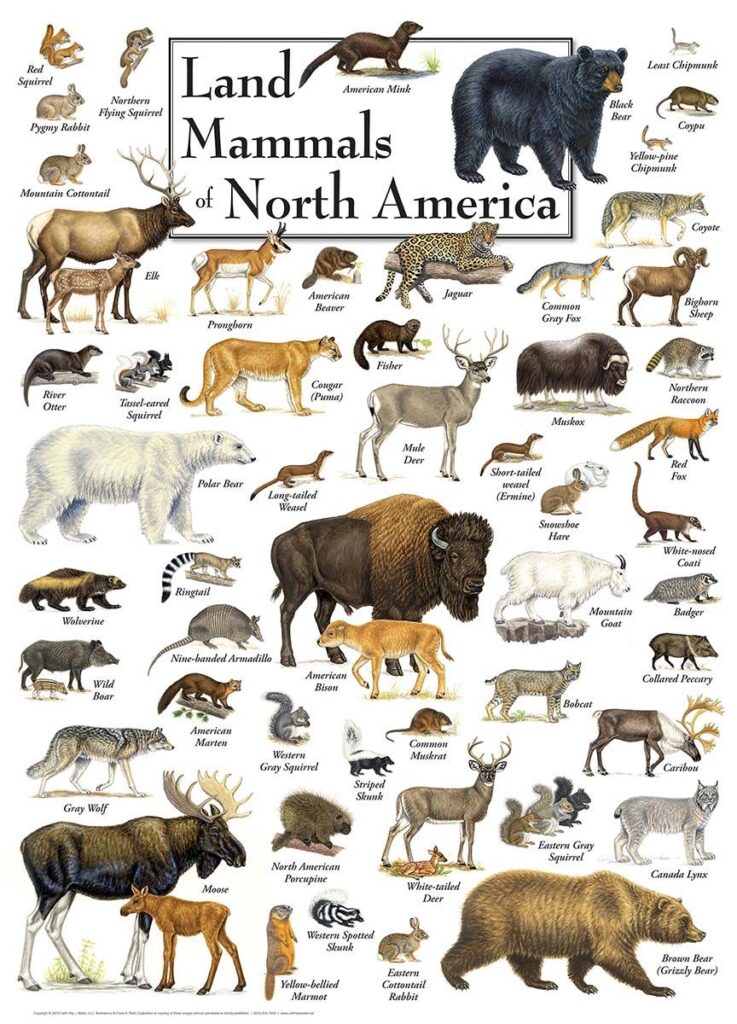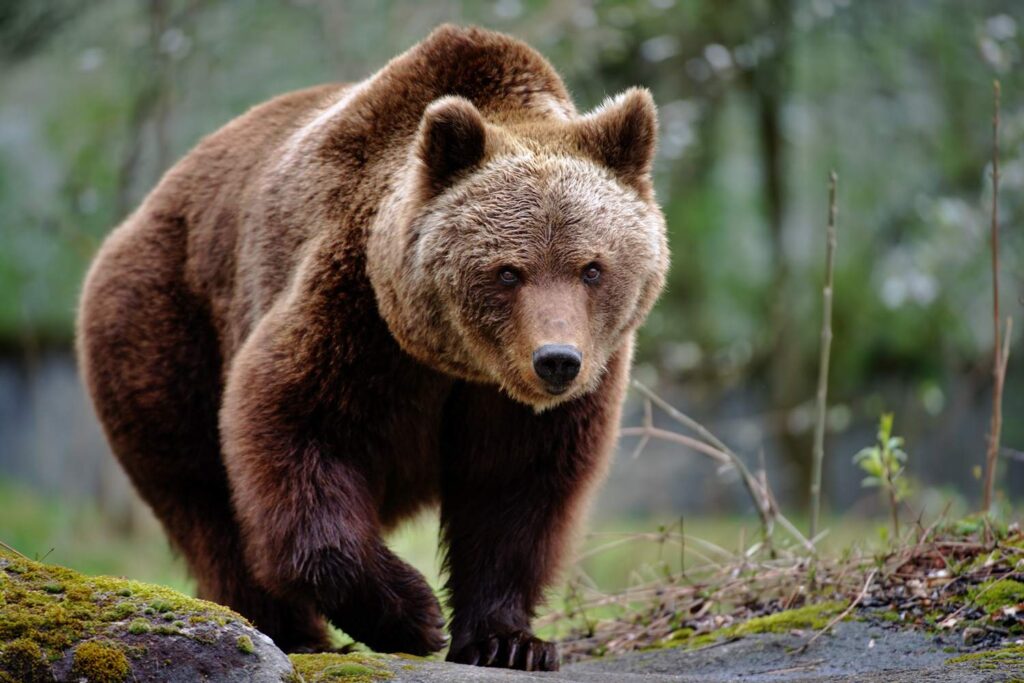
So, you’re looking to learn about some of the fascinating creatures that call North America home? Well, you’re in luck! In this article, we’ll take a closer look at the diverse array of animals that are unique to this vast continent. From the majestic bald eagle soaring through the skies to the elusive mountain lion prowling through the forests, you’ll discover the incredible wildlife that makes North America truly one-of-a-kind. So, let’s jump right in and embark on an exploration of the remarkable animals found exclusively in North America.
The American Bison
Features and Characteristics
The American Bison, also known as the American buffalo, is an iconic symbol of the American West. It is a large mammal that can reach heights of up to six feet at the shoulder and weigh over 2,000 pounds. The bison has a distinct hump on its back and a massive head with a thick, shaggy mane of hair. Both males and females have short, curved horns.
Habitat and Distribution
Originally, American bison roamed across the vast grasslands of North America, from Canada down to Mexico. However, their habitat has significantly diminished due to human activities and habitat loss. Today, they can be found in protected areas, such as national parks and reserves. Some herds have been reintroduced in parts of their former range, but they still face challenges in reclaiming their historic distribution.
Conservation Status and Threats
The American bison was once on the brink of extinction, with a population of fewer than 1,000 individuals in the late 1800s. However, thanks to conservation efforts and the establishment of protected areas, the population has rebounded to around 500,000 animals. Despite this increase, the bison still face threats such as habitat destruction, hunting, and disease transmission from domestic livestock. Continued conservation efforts are crucial to ensuring the long-term survival of this iconic species.
The Pronghorn
Physical Attributes
The pronghorn is a unique and graceful animal native to North America. It is known for its speed and agility, being capable of reaching speeds of up to 60 miles per hour, making it the fastest land animal in the Western Hemisphere. Its most distinctive feature is its branched horns, which can grow up to 20 inches in length.
Habitat and Range
Pronghorns are adapted to various habitats, including grasslands, shrublands, and desert regions. They are primarily found in western North America, from the Rocky Mountains to the Mexican border. These animals are highly adaptable and can survive in diverse environments, as long as there is access to open spaces and a reliable water source.
Diet and Behavior
Pronghorns are herbivores, feeding on a diet mainly consisting of grasses, forbs, and shrubs. They have specialized teeth and a unique digestive system that allows them to efficiently extract nutrients from their fibrous diet. Pronghorns are also known for their distinctive courtship behavior, known as “pronging,” where they perform graceful leaps into the air.
Predators and Conservation
Pronghorns have a few natural predators, including coyotes and mountain lions. However, the main threats to their survival are habitat fragmentation and human disturbances such as agriculture, urban development, and roads. Conservation efforts focus on preserving their habitats, managing predator populations, and ensuring safe migration routes. By protecting pronghorns and their ecosystems, we can help ensure the long-term survival of this remarkable species.

This image is property of www.animalspot.net.
The Florida Panther
Appearance and Traits
The Florida Panther is a subspecies of the mountain lion and is one of the rarest large mammals in North America. It has a tan or brown coat, with darker markings on its face, tail, and lower back. Males are typically larger than females, weighing between 100 and 160 pounds. The Florida Panther has keen senses, including excellent night vision, which aids in its hunting activities.
Environment and Distribution
The Florida Panther is found exclusively in southern Florida, particularly in the Everglades and surrounding habitats. It requires a mix of upland forests, wetlands, and open areas for hunting. Unfortunately, due to habitat loss and fragmentation caused by urbanization and agricultural activities, the Florida Panther’s range has significantly diminished, leading to population isolation.
Diet and Survival Tactics
The Florida Panther is a carnivorous predator, primarily feeding on white-tailed deer, wild hogs, and smaller mammals. It relies on stealth, agility, and its powerful pounce to capture prey. However, as habitat loss reduces the availability of natural prey, panthers may also resort to feeding on livestock, increasing conflicts with humans.
Challenges and Protection Measures
The Florida Panther faces numerous challenges to its survival. Habitat loss, collisions with vehicles, genetic inbreeding, and diseases transmitted by domestic cats are among the major threats. Conservation efforts focus on protecting remaining habitats, establishing corridors for migration, and implementing genetic management to increase genetic diversity. By safeguarding the Florida Panther, we can help maintain the ecological balance of its unique South Florida habitats.
The Nine-Banded Armadillo
Description and Features
The nine-banded armadillo is a small to medium-sized mammal known for its armored shell. It has a stocky body covered in bony, overlapping plates, which provide protection against predators. Armadillos have a long, flexible snout, sharp claws for digging, and a long tail. They can vary in color, ranging from light gray to dark brown.
Habitat and Geography
Native to the Americas, the nine-banded armadillo is primarily found in the southern United States, from Texas to Florida. It prefers habitats with loose, sandy soils, such as grasslands, savannas, and forests. Armadillos are excellent diggers and create burrows for shelter and nesting, sometimes even sharing their dens with other armadillos.
Diet and Lifestyle
Armadillos have a predominantly insectivorous diet, feeding on ants, termites, beetles, and worms. They use their sharp claws to dig for food in the soil and leaf litter. Due to their slow metabolism and low body temperature, armadillos are mainly active at dawn and dusk. They are solitary animals, only coming together to mate or care for their young.
Conservation Actions and Threats
The nine-banded armadillo is currently considered a species of least concern by the International Union for Conservation of Nature (IUCN) due to its large population and adaptability. However, they are vulnerable to habitat destruction and road mortality. Conservation efforts aim to protect their habitat, mitigate vehicle collisions, and raise awareness about the importance of preserving these unique creatures.

This image is property of i.redd.it.
The American Pika
Physical Characteristics
The American Pika is a small mammal that resembles a chubby, round-eared rabbit. It has a compact body covered in dense fur, which helps insulate it in its alpine habitat. It has a short yet distinctive tail and large, round eyes that provide excellent vision in low light conditions.
Habitat and Range
The American Pika is found in rocky alpine regions of western North America, from the high mountains of the Sierra Nevada to the Rocky Mountains. They depend on cool, moist microhabitats created by rocky outcrops, talus slopes, and meadows. As climate change threatens the stability of their habitat, pikas have been gradually moving to higher elevations seeking cooler temperatures.
Feeding Habits and Behavior
Pikas are herbivores that feed primarily on grasses, sedges, and flowering plants during the summer months when food is abundant. They have a remarkable ability to store vegetation in “haypiles” within their rocky burrows, which they rely on during the long winter season. Pikas are highly territorial and use distinctive vocal calls to communicate with one another.
Protection Status and Threats
The American Pika is considered to be a species of concern due to its vulnerability to climate change. As temperatures rise, the suitable habitat for pikas becomes limited, potentially leading to population declines or even local extinctions. Conservation efforts focus on monitoring their populations, protecting their alpine habitats, and reducing the impacts of climate change to ensure their long-term survival.
The Black-Footed Ferret
Physical Attributes
The Black-Footed Ferret is a charismatic and endangered carnivore native to North America. It has a slender body, long neck, and short legs. Its fur is pale yellow to buff with dark brown markings, and it has distinctive black markings on its feet, ears, and face. Black-Footed Ferrets have sharp, retractable claws and teeth adapted for hunting small mammals.
Habitat and Territory
Historically, the Black-Footed Ferret inhabited the mixed-grass prairies of North America. However, due to habitat loss and the decline of their main prey, the prairie dog, their range has significantly decreased. Currently, they are found in fragmented populations in parts of the United States, Mexico, and Canada.
Diet and Preying Techniques
Black-Footed Ferrets are specialized predators that rely almost exclusively on prairie dogs for food. They reside in prairie dog burrows and venture out at night to hunt the rodents. They use their keen hearing and smell to locate prey, and their slender bodies enable them to navigate through complex burrow systems. Despite their hunting prowess, the decline of prairie dog populations has severely impacted the ferret’s survival.
Conservation Efforts and Challenges
The Black-Footed Ferret is one of the rarest mammals in North America, and its population was once thought to be extinct. However, a small number of individuals were discovered in the 1980s, leading to intensive conservation efforts. These efforts involve captive breeding programs, reintroductions into suitable habitats, and prairie dog conservation initiatives. However, ongoing challenges such as habitat loss, disease transmission, and climate change continue to threaten the survival of this endangered species.

This image is property of i.pinimg.com.
The Northern Spotted Owl
Features and Identification
The Northern Spotted Owl is a medium-sized, dark-eyed owl with characteristic chocolate-brown plumage covered in white spots. It has a rounded head with long feathers known as “ear tufts,” even though they are not actually ears. Their large, dark eyes provide exceptional night vision, allowing them to navigate through dense forests.
Habitat and Distribution
The Northern Spotted Owl is native to the old-growth forests of the Pacific Northwest, particularly in Washington, Oregon, and northern California. These owls rely on mature forests with large trees for nesting, roosting, and foraging. However, increased logging and habitat degradation have severely impacted their population and range.
Diet and Nesting Habits
The Northern Spotted Owl is a nocturnal predator that primarily feeds on small mammals, such as flying squirrels, mice, and voles. They are also known to hunt birds and occasionally consume reptiles and amphibians. They nest in tree cavities or utilize abandoned nests of other large birds, such as hawks or crows.
Conservation Status and Concerns
The Northern Spotted Owl is listed as a threatened species under the Endangered Species Act in the United States. Habitat loss, primarily due to logging and wildfires, has been the main driver of their decline. Conservation efforts focus on preserving old-growth forests, implementing sustainable logging practices, and managing competition from the invasive barred owl. Protecting the Northern Spotted Owl is crucial for maintaining the health of its forest ecosystem.
The Gila Monster
Appearance and Characteristics
The Gila Monster is a venomous lizard native to the southwestern United States and northwestern Mexico. It has a heavyset body covered in black and orange or pinkish-colored scales arranged in distinctive bead-like patterns. This reptile has a stout tail, a blunt snout, and a forked tongue that helps it detect prey.
Habitat and Range
Gila Monsters inhabit arid and semiarid regions, particularly rocky areas such as deserts, canyons, and scrublands. They are mostly found in the Sonoran and Mojave deserts of the southwestern United States and northern Mexico. Due to their reliance on specific habitats, their distribution is limited to these areas.
Feeding Patterns and Behavior
Gila Monsters are opportunistic predators, feeding on small mammals, birds, eggs, reptiles, and occasionally carrion. They have a specialized venomous bite that immobilizes their prey, allowing them to consume it at their leisure. To conserve energy, they have a slow metabolic rate and can go for long periods without eating.
Protection Measures and Threats
The Gila Monster is a protected species, and both its possession and capture are highly regulated due to its threatened status. Habitat loss, road mortality, and illegal collection for the exotic pet trade are among the significant threats to their survival. Conservation efforts aim to protect their natural habitats, enforce strict regulations on trade and captive breeding, and educate the public about the importance of preserving these unique reptiles.

This image is property of www.thoughtco.com.
The Sonoran Desert Toad
Physical Description
The Sonoran Desert Toad, also known as the Colorado River Toad, is a large and robust amphibian found in the southwestern United States and northern Mexico. It has a thick, warty skin that ranges in color from olive or brown to beige. These toads have distinctive parotoid glands behind their eyes, which secrete a potent toxin.
Habitat and Geography
Sonoran Desert Toads inhabit arid and semiarid regions, including the Sonoran Desert, the Colorado River basin, and other nearby desert areas. They are mainly found in sandy or rocky habitats with access to permanent or seasonal water sources, such as streams or desert pools.
Food and Behavior
Sonoran Desert Toads are mainly active during the monsoon season when rainfall triggers their breeding activity. They feed on a variety of invertebrates, including beetles, ants, spiders, and centipedes. Toads are primarily nocturnal, seeking shelter in burrows or under rocks during the day to avoid the intense heat of the desert.
Conservation Issues and Status
The Sonoran Desert Toad faces several conservation challenges. Habitat destruction, fragmentation, and pollution are significant threats to their survival. Additionally, their toxin has led to illegal collection for recreational use, posing a risk to both wild populations and individuals who handle them. Conservation efforts aim to protect their habitats, regulate toxin use, and educate the public about the role these toads play in desert ecosystems.
The Glacier Bay Water Boatman
Characteristics and Behavior
The Glacier Bay Water Boatman is a unique insect that inhabits the icy waters of Glacier Bay, Alaska. These tiny insects, not much larger than a grain of rice, are excellent swimmers and are capable of living in water temperatures near freezing. They are adapted to breathe through their abdomen, allowing them to extract oxygen directly from the water.
Habitat and Locality
As the name suggests, the Glacier Bay Water Boatman is found exclusively in Glacier Bay, a fjord in southeastern Alaska. This insect thrives in the cold, glacial waters and is well-adapted to the extreme conditions of its habitat. It can be found in freshwater ponds, lakes, and streams within the bay.
Dietary Habits and Survival
The Glacier Bay Water Boatman is a herbivorous insect, feeding on algae and other small aquatic plants. It uses its specially adapted mouthparts to scrape algae off rocks or other submerged surfaces. Despite the limited food availability in its glacial environment, the Water Boatman is well-suited to survive and reproduce in this challenging ecosystem.
Conservation Situation and Threats
The Glacier Bay Water Boatman is considered to be a species of least concern due to its restricted and relatively well-protected habitat. However, the impacts of climate change, including glacial retreat and changes in water temperature and chemistry, could potentially affect the survival of this unique species. Continued monitoring and research are essential to understand and mitigate the potential threats to the Glacier Bay Water Boatman and its delicate glacial ecosystem.
In conclusion, North America is home to an incredible variety of unique and fascinating animals. From the majestic American Bison to the elusive Northern Spotted Owl, each species plays a vital role in its ecosystem. However, many of these animals face significant conservation challenges due to habitat loss, climate change, and other human-induced threats. It is crucial that we continue to prioritize their protection and work towards ensuring their long-term survival. By preserving their habitats, implementing sustainable practices, and raising awareness, we can help safeguard these remarkable creatures for future generations.






